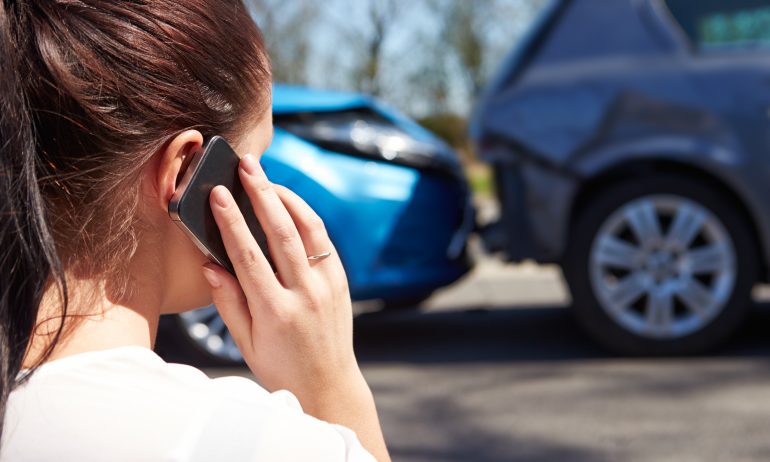What Is Collision Insurance and Do You Need It?

Many or all of the products featured here are from our partners who compensate us. This influences which products we write about and where and how the product appears on a page. However, this does not influence our evaluations. Our opinions are our own. Here is a list of our partners and here's how we make money.
Collision insurance reimburses you to fix or replace your car if you crash into another car or object. It can also pay for hit-and-runs, roll-overs and damage caused by uninsured or underinsured drivers.
Most lenders require you to have collision coverage if you finance or lease your car.
Collision insurance might be worth it if you’d have a hard time paying to repair or replace your wrecked car on your own.
As the name suggests, collision coverage pays to repair or replace your car when you collide into another vehicle or object such as a lamppost or curb. It may also pay if another driver hits your car and doesn’t have enough insurance to pay for the damage.
Collision insurance is optional if your car’s paid off. But if you finance or lease it, it’s likely required by your financing company until the contract ends.
Here’s what we’ll cover in this article:
What does collision insurance cover?
Collision insurance pays for damage to your own car from: |
|
Collision insurance won’t pay for: |
|
If your car is damaged but not totaled: Collision insurance pays to repair your car to its previous condition, minus your deductible.
If your car is totaled: Collision insurance will pay the actual cash value of your vehicle, minus your deductible. Without collision insurance, if disaster strikes, you could be stuck paying thousands of dollars for car repairs or for a new vehicle.
If your car is totaled and you have a loan that’s more than the value of your car, you’ll still have to pay the remaining balance on your loan, which can be thousands of dollars. If you have a newer vehicle, it’s a good idea to ask your insurer about gap insurance, which can help cover the difference and pay off the loan.
How collision insurance works when the other driver is at fault
If you’re in a crash and another driver is entirely at fault, that driver’s liability car insurance pays for damage to your car.
However, in many states, liability auto insurance minimum limits are low — just $5,000 or $10,000. Given that the average cost of a new car is nearly $50,000, a driver with only state-required liability coverage wouldn’t have enough to pay for a newer vehicle that's totaled. If you're in an accident and the at-fault driver’s liability limits are too low, then your collision insurance would kick in to pay for your car’s damage.
Collision insurance vs. comprehensive insurance vs. full coverage insurance
While collision coverage pays for collisions, comprehensive insurance pays for non-crash damage to your vehicle, such as fire, hail or theft. The combination of collision and comprehensive insurance, combined with liability insurance, is typically referred to as full coverage car insurance.
Learn more in our collision vs. comprehensive insurance explainer.
Do you need collision insurance?
Much like your car, collision coverage becomes less valuable over time, because it will never pay out more than the car’s value. If you don’t have a loan or lease requiring it, collision insurance eventually loses its worth, costing more to have than it would pay you after a crash.
Use NerdWallet’s collision insurance calculator below to determine if it’s worth it for you.
If you decide collision insurance is worth it for now, revisit this calculator as your car ages and anytime you get car insurance quotes.
How collision insurance works
Let’s say you weren’t paying attention in a parking lot and slammed into a curb, damaging your car’s front suspension and other critical parts. Here’s how collision insurance would work:
You document the damage and call your insurer. You discover you’ll be reimbursed for repairs if you file a claim.
Your deductible is $1,000, and the damage will clearly cost more than that to repair, so you decide it’s probably worth filing a claim.
Because you also pay for roadside assistance (a fairly inexpensive add-on), your insurer will even pay to tow your car to its preferred repair shop. While you can select your own mechanic for repairs, you decide it’s worth going with your insurance company’s recommended garage because your insurer will guarantee the repairs for as long as you have the car, and it can pay the garage directly.
Your insurance company sends an insurance adjuster to inspect your car and estimate initial repair costs. The adjuster's estimate is $4,100.
You accept the estimate.
Because you also pay for rental reimbursement coverage on your car insurance policy (an add-on that’s typically only available after purchasing comprehensive and collision insurance), your insurer covers the cost of a rental car while yours sits in the shop.
You’re notified that your car is repaired and ready to be picked up. But before you can drive your car home, you pay the auto repair shop $1,000 to cover your deductible.
» MORE: What does car insurance cover?
Reducing or waiving your collision deductible
Keep in mind that your collision deductible applies even when you’re not at fault for damage to your car. If the at-fault driver doesn’t have sufficient insurance to pay for the damage and you don’t have underinsured or uninsured motorist property damage coverage (UMPD), collision insurance would pay for the damage.
If it seems unfair that you’d have to shell out to fix damage caused by someone else, you might want to consider reducing or eliminating your insurance deductible — which raises the price of your insurance policy — or adding a collision deductible waiver to your policy. Available only in some states, this waives your deductible if an uninsured driver causes an accident and your collision coverage has to pay.
Another way to reduce your collision deductible burden after an accident is by adding “disappearing deductibles” (which go by several similar monikers) to your policy. Some auto insurance companies will reduce your deductible by a certain amount — typically $100 — for each year you go without an accident or ticket. Details vary by company, but disappearing deductibles generally cost extra and may not end up being worth it if you aren't ever in an accident.
» MORE: Compare car insurance rates
How much does collision insurance cost?
Depending on the company, you might not be able to buy collision insurance without comprehensive coverage, or vice versa. This could be because you have an active loan or lease that requires both, or because your insurer requires one to purchase the other.
According to NerdWallet’s January 2024 analysis of national car insurance rates, the average cost for full coverage insurance is $1,982 per year. But your own rates will likely be different. That’s because car insurance companies base their rates on a variety of factors, such as the car you drive, how many miles you drive and where you live.
» MORE: Why is my car insurance so high?
Choosing a higher deductible can lower your premium, as long as you can cover the out-of-pocket costs if you need to file a claim.
NerdWallet averaged rates based on public filings obtained by pricing analytics company Quadrant Information Services. We examined rates for 35-year-old men and women for all ZIP codes in any of the 50 states and Washington, D.C. Drivers had good credit and a good driving history. Although it’s one of the largest insurers in the country, Liberty Mutual is not included in our rates analysis due to a lack of publicly available information.
In our analysis, “good drivers” had no moving violations on record; a “good driving” discount was included for this profile. Our “good” credit rates are based on credit score approximations and do not account for proprietary scoring criteria used by insurance providers. These are average rates, and your rate will vary based on your personal details, state and insurance provider.
Sample drivers had the following coverage limits:
$100,000 bodily injury liability coverage per person.
$300,000 bodily injury liability coverage per crash.
$50,000 property damage liability coverage per crash.
$100,000 uninsured motorist bodily injury coverage per person.
$300,000 uninsured motorist bodily injury coverage per crash.
Collision coverage with $1,000 deductible.
Comprehensive coverage with $1,000 deductible.
In states where required, minimum additional coverages were added.
We used a 2021 Toyota Camry LE in all cases and assumed 12,000 annual miles driven.
On a similar note...




